#diverse worldbuilding
Text
so within the universe of Dune, gender roles abide by a rigid false dichotomy created by the bene gesserit - men lead the noble houses, while the women may join their order, and the powers of both are kept intentionally separate. at the same time, the plot demonstrates repeatedly that the role of paul atreides as a character is that of the border between the concepts juxtaposed within dichotomies: he is both an outerworlder and fremen, both harkonnen and atreides, both a duke and a disciple of the bene gesserit.
as such, it follows that within the in-universe gender structure, he occupies the roles of both male and female, thus being functionally and societally nonbinary. in this essay, i will -
#dune#paul atreides#diversity win! this aspiring space dictator is nonbinary#dune 2024#atreides#bene gesserit#gender lens#dune meta#this is probably very obvious and already talked about but i had to get it out#i think it's also supported by the original intent behind his birth. as in he was supposed to be a girl etc#gender roles#worldbuilding
5K notes
·
View notes
Text
"the creator said in a reddit thread -" "the official twitter account posted that -" "the actors confirmed in a livestream that -"
i don't care and that's not real to me. put it in the text.
#for fun stuff like 'this character's favorite food is meatballs' im like cool but for worldbuilding and stuff? nah#i do understand some nuance with writers or w/e who were held back by corporate teams on confirming a character is gay or something#and wanting to talk about their hopes and intentions#but this is rly about the opposite with creative teams wanting the points for diversity or plot choices#or world building without putting it in the actual story#esp if its bc they just didn't want to piss off bigots or can't write well#sw giving backstory on the sith fleet situation in a TWEET will always be infamous to me#not st#doctor's log
1K notes
·
View notes
Note
I'm loving your oc stuff too!!! Do you think we could get some (non spoilery) info about them?
Sure :] Cameron (right) is a barista living in her hometown with her younger sister she and is not thrilled about any of these things. Ari (left) writes articles about paranormal/hokey true crime stuff for a buzzfeed-knockoff type of website after quitting her phd. Theyre both mid-20s and also both gay but Cameron is very closeted
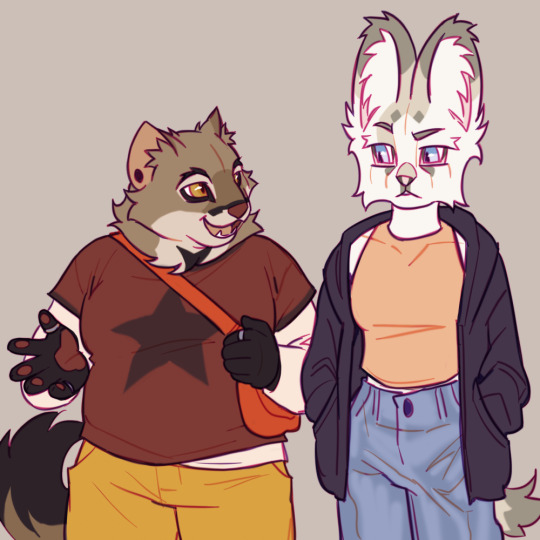
Ari's phd program was in vertebrate evolution, specifically feline phylogenetics, which segues into my worldbuilding that I've also wanted to talk about lol. All the characters in this world are based on cats from subfamily Felinae – basically all small wildcats combined into one sapient species instead of humans. The characters I've designed so far are inspired by specific cats (Cameron is based on a serval and Ari on a pampas cat) but I'm not trying to stick too closely to that since they're all meant to be the same species from a worldbuilding perspective. No domestic cats (furry or animal) but regular big cats are still a thing, basically akin to great apes vs humans. Anthropomorphic cougars and cheetahs are a thing but are extinct, like extinct hominids. Basically my effort to shove cats into a human evolution parallel lol
#this sounds boring but just know that I am withholding kind of the most important part and premise of the story LOL#the worldbuilding aspect is plot relevant also at least from a conceptual perspective#ask#aerielart#oc: ari#oc: cameron#from a technical perspective pulling designs from multiple cat species helps with more design variation#which I liken to how humans are extremely phenotypically diverse esp with a relative lack of genetic diversity compared to other species
288 notes
·
View notes
Text
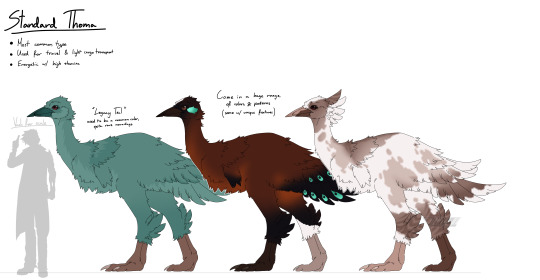
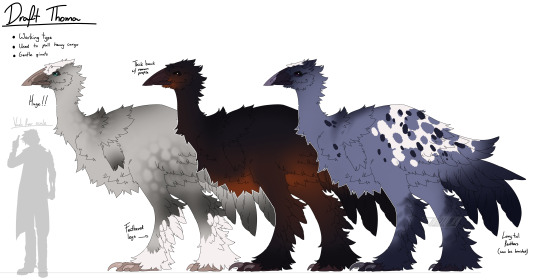

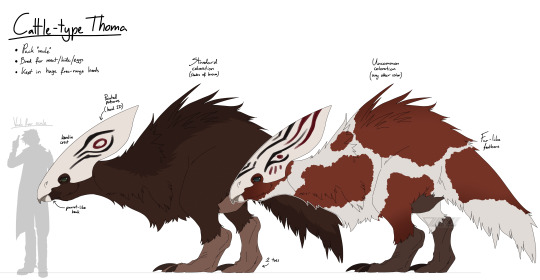
cowboy au worldbuilding with the thoma
as you can see im taking some creative liberties with the giant emu by making them more diverse bc canon isnt enough for me and i have the brainworms
extra notes below the cut
standard thoma:
the original thoma and most common type available
perfect for travel, can pull wagons or carry light cargo
fast with good stamina, fastest over short distances
friendly, intelligent, energetic and quick to learn
the most diverse in terms of colors, patterns and extra traits
well rounded in all departments (theyre like the AQ horses of trigun)
draft thoma:
uncommon outside of major cities (kept by specialized breeders)
used for construction work and long haul heavy cargo transport
gentle, patient and eager to work
not built for speed but can walk for days at a steady pace without rest
dense feather coat protects them from the heat and sand
expensive to maintain and keep due to their size
theyre a relatively new type that came from selective breeding
"wild" thoma:
actually feral (aka. previously domesticated), not wild
originating from lost/runaways that have not been in contact with humans for generations
rare and elusive with a small population, sometimes spotted living near shipwrecks
people will pay top $$ for their capture
begin to exhibit adaptive mutations that help them survive the wastelands
smaller and less fluffy than their standard counterparts
dont come in many colors, mostly bays, chestnuts and blacks
hardy with incredible endurance
very stubborn, temperamental and intelligent, cant be forced to do something they dont want (like donkeys)
rarely ridden, mostly kept for crossbreeding
cattle-type thoma:
related to the standard thoma but NOT the same species
common pack animal in caravans, sometimes ridden as a cheaper alternative to the standard thoma
mainly bred for meat, hide and eggs
kept in huge open range herds that travel along worm swarms for feeding
sometimes kept as a form for anti-worm pest control
keratin crests are lightweight and used for protection and display
ranchers will paint patterns on their crests as a form of identification
not the sharpest tools in the shed, tend to bite and trample people
#trigun#trigun stampede#cowboy au#worldbuilding#andr0art#i like speculative biology idk what to tell you#its the brainworms#sorry for the horrible handwriting btw#also ik that significant adaptive mutations take longer to appear than a 100 years#but lets say they adapt fast due to genetic modification#the implications of what seeds did after the fall to adapt to the wastelands fascinates me#since thoma arent native to no mans land iirc#did they just have them on board?#what ab other animals?#what kind of non-native wildlife is there#i know there are birds and like... a cat#<- still hasnt read trimax#everything i know has been obtained via tristamp and osmosis#also yes im bringing in the og thoma#diversity win!#i needed a substitute for cows so vash and wolfwood have something to herd for cash#living the cowboy dream baby!
500 notes
·
View notes
Text
Omega Fashion

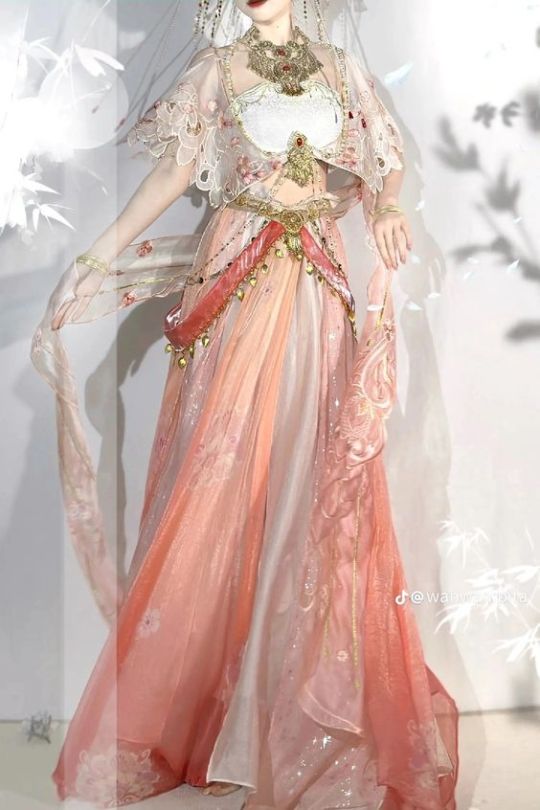
The main difference between omega fashion and other dynamics is the division they use. In alpha and beta fashion, the clothing is divided by the first gender, male or female. In omega ones, the clothing is divided by development stages of the omega in question: Immature -> Mature and Unmated -> Mature and Mated -> During and Post pregnancy. Those stages show significant milestones that omega hit and every transition from one to another is often celebrated by their families.
The clothes in question have the most variety and complexivity of all the secondary genders. They often make a point to show off omega's social status in question, resulting in razzle dazzle type of clothing, regardless of division. The unsaid social rule states that omegas' overall image represent the wellness of the house, ensuing a custom where omegas are often pampered with multitude of robes, jewelry and trinkets.
Immature Omegas


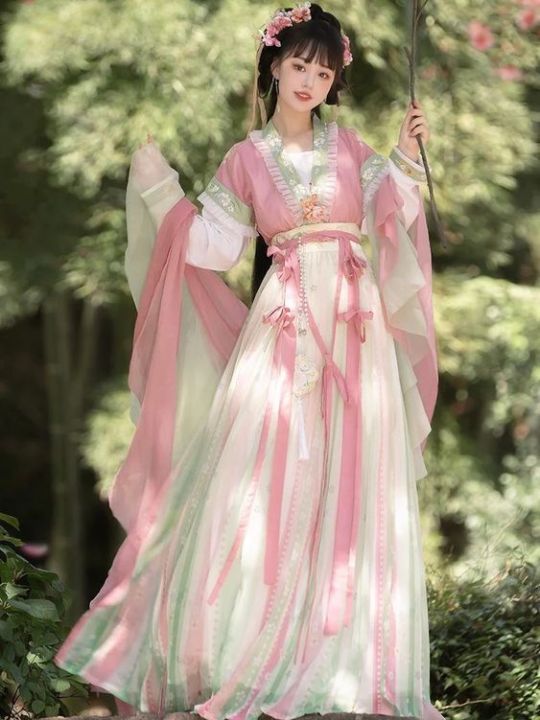
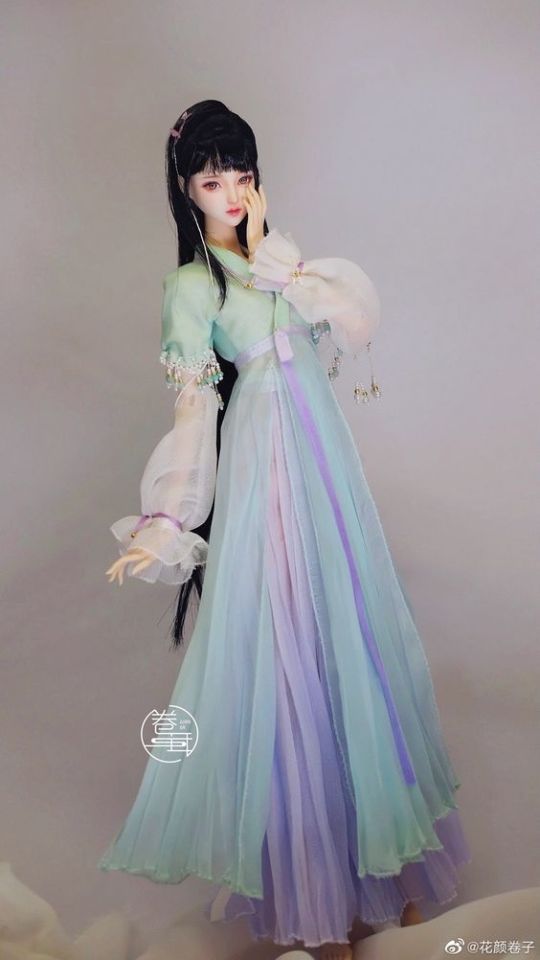
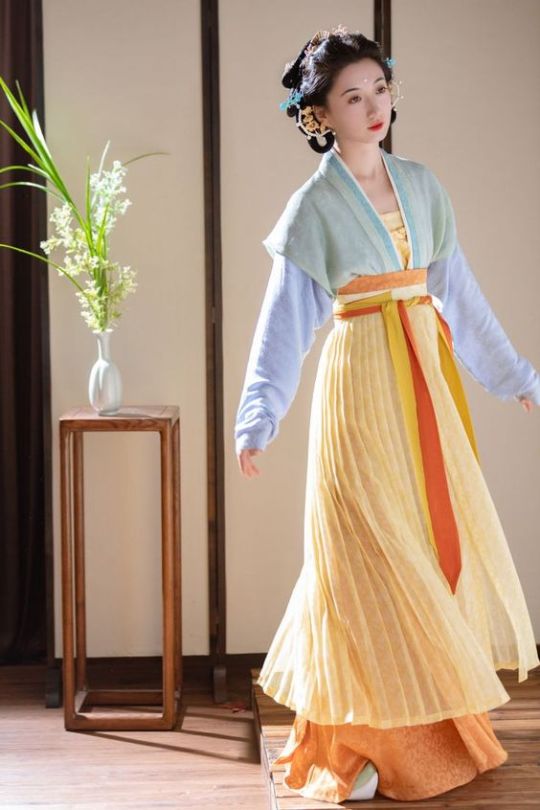
Omegas typically wears those clothes from their presentation up untill the age of 18-19 where they will then be considered mature. The clothing style consists of Long, multilayered skirt, a long sleeved underrobe,strap tank and an overrobe with short wide sleeve. The clothes are to show off omegas innocence and childishness ( that they have, lets not forget that they are under 18 and considered a child). They are often easy to wash and breathable. When it comes to an omegas neck and wrist areas, they are often covered by simple neck necklaces and wrist warmers.
Mature and Unmated Omegas
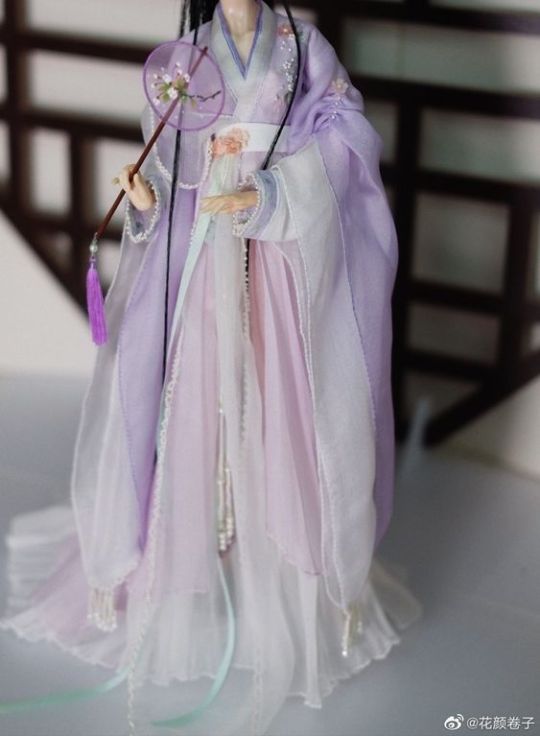
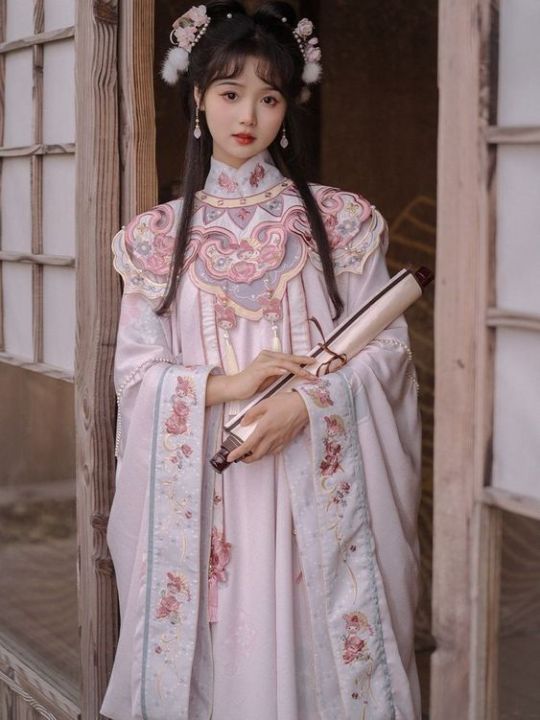

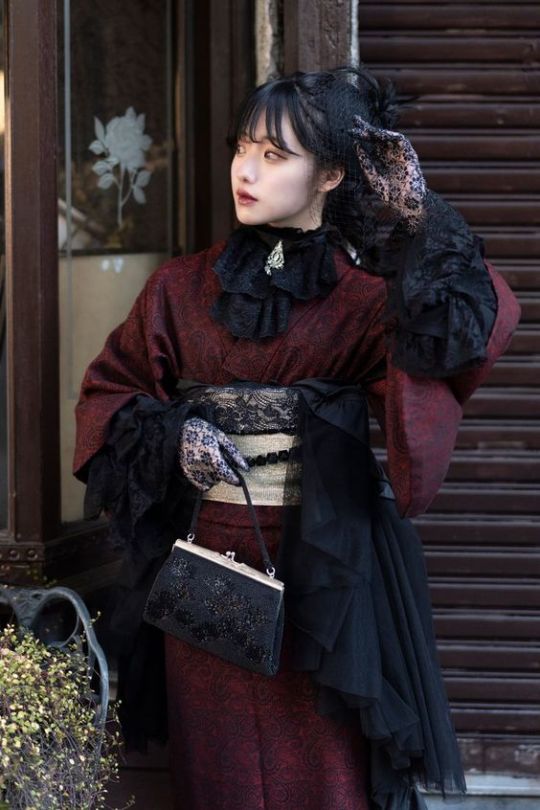


It's the stage where omega is at 18 years of age and considered eligible for mating and marriage. The fashion favours many layers and body modesty. The clothes are often elaborate and eye-catching where omega's beauty is accentuated with careful layers and jewelry. They range from body fitting to loose, light to dark coloured etc. During this stage there will be time where omega will start to court people. You can discern fully single omega and courting one by one difference- the jewelry. Single omega's jewelry around ones neck is often simple but covering omegas neck fully with matching wrist bracelets covering their scent glands whereas courting omega's jewelry will be more elaborate and detailed. There is also a trend in fashion where omega will wear nail jewelry, that is small and unasuming but adding elegant touch.
Mature and Mated Omegas



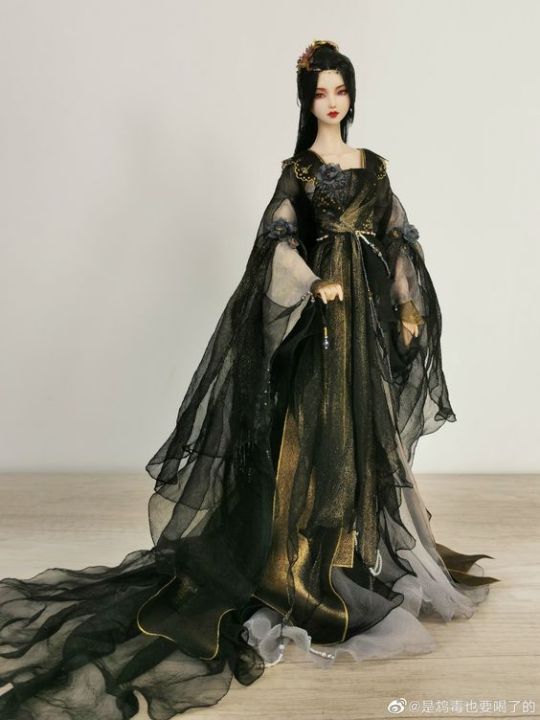
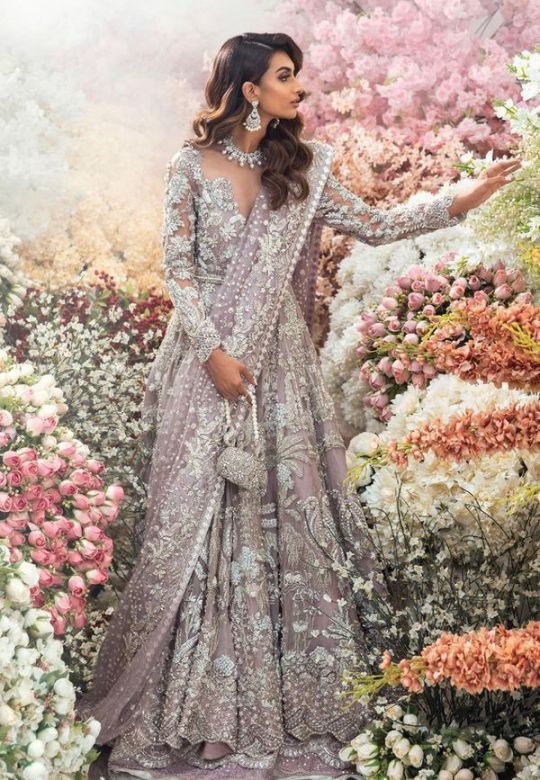

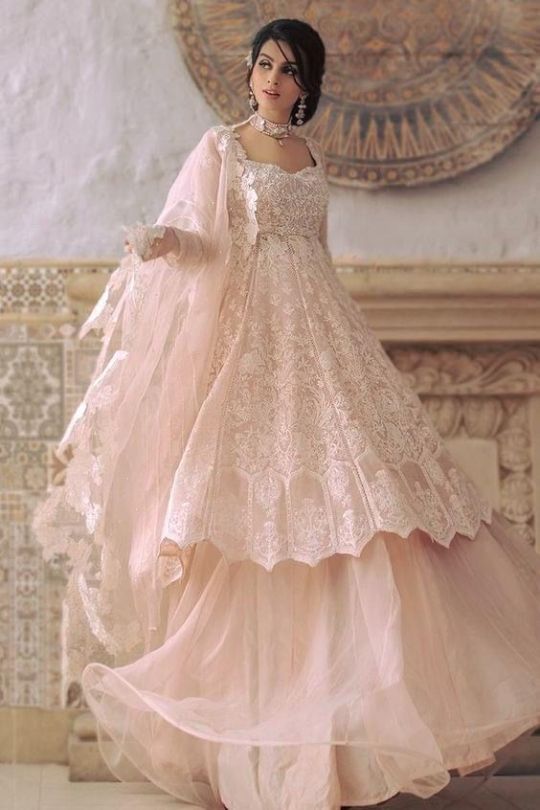
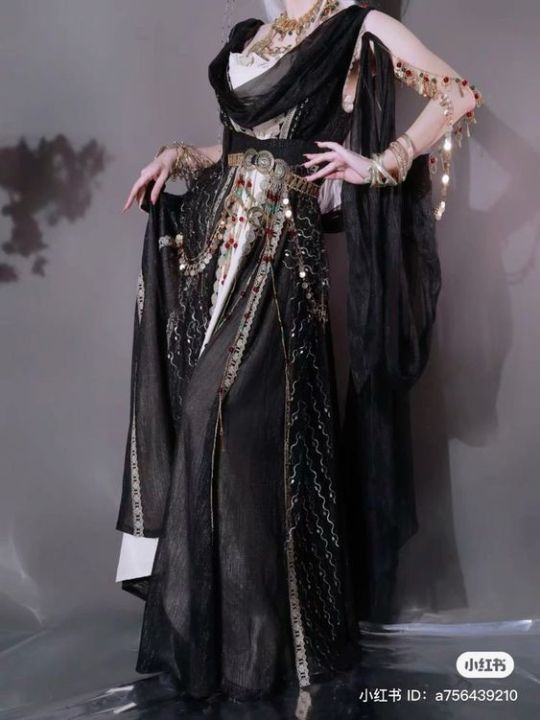
This clothing stage focuses on showing off shoulder and neck area, where mating bite resides. This fashion division makes it known that omega is off limits and dazzling with happiness. There is present large amount of decorations, jewelry and layers. Those mated omegas often really invest in how they look to show off themselves and their mates as a sign of pride and fullfilment. Furthermore this fashion isnt only reserved for omegas without children, Omegan mothers can fluidly switch between the maternal fashion and mated one as both of them kinda coexist together, it is matter of preference tho which fashion individual omega prefers. The nail jewelry is also present where omegas lets their nails grow to bigger lenghts while still being unobtrusive when permorming tasks.
During and Post Pregnancy

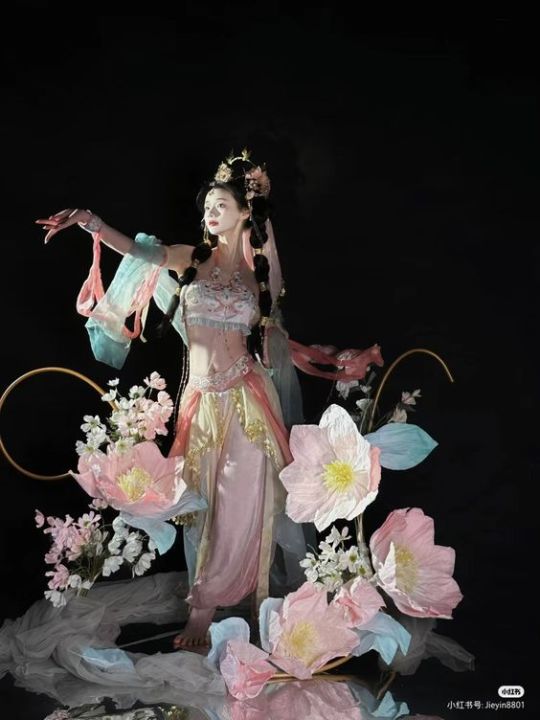
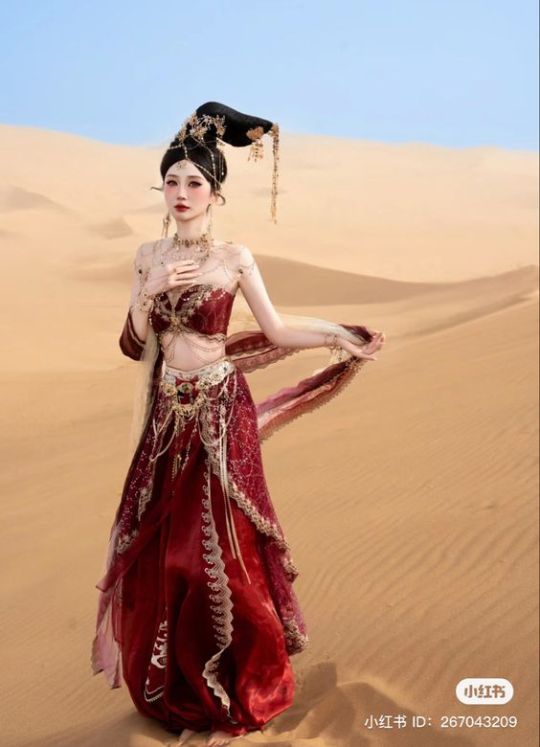


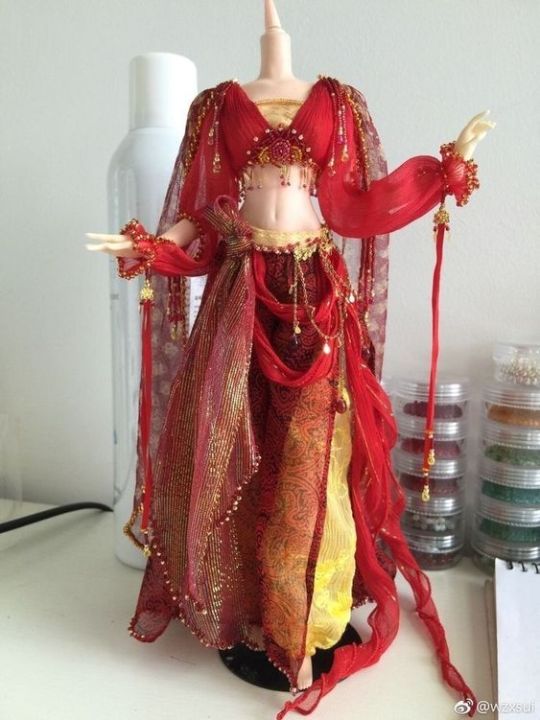

This fashion is reserved for expecting and present mothers, where they want to show off omega's belly and neck area on full display. Those clothes offer more mobility and freedom than all previous divisions and try to put omegas in ,,godlike'' clothes to represent their strength and beauty while carrying their young. Even omegas who are after childbirth often still remain in those clothes to show off their ,,mom bod'' and fertility.
#a/b/o dynamics#a/b/o#omegaverse worldbuilding#omegaverse headcanons#a/b/o verse#omega#omegaverse#We love them diversity and cultures#Had to put my noggin on 100% for this one
55 notes
·
View notes
Text
On Heteromorphs & Heteromorphobia (Arcs VI - X , Hero Killer to Provisional License Exam)
(This post will also cover the bonus chapter “Tsuyu's Ribbity Diary.”)
Thank you all for your amazing response to last week's post, my goodness! I thought I'd found about all the audience I was likely to get for my harping about heteromorphic discrimination, so I was delighted to see a number of new names!
I do have to warn you all, if you haven't done much looking into my archives, that I'm pretty critical of BNHA these days, especially of the ways it insists on holding up individualistic solutions to problems clearly established as systemic in nature. That will become more apparent when I get into the post-war material, as the endgame is absolutely rotten with it.
This week, though, we'll start by getting out of the school to get a look at signs of and contributors to heteromorphobia in the wider world.
The Vs. Hero Killer Arc (Chapters 45-59)
Chapter 45:
Mina’s preferred alias, Alien Queen, in reference to the Xenomorph queen from the Aliens franchise, is turned down by Midnight. The reason for this is never made especially clear. Class 1-B gets away with a number of villainous or monstrous hero names, like Phantom Thief and Gevaudan, violent ones like Battle Fist, even an animal reference in Jack Mantis. But Mina, for whatever reason, gets pushed towards the indescribably twee Pinky instead. Does Midnight the R-rated hero not think girls should get to have hero names with some edge? Surely not; her entire persona is based on titillation. Length is clearly not a factor, given that Midnight personally approves Can’t Stop Twinkling.
I don’t know exactly what went down here (from a Watsonian perspective, that is; the Doylist guesses are readily apparent and all eyeroll-inducing), so I will simply point out that a non-baseline gal wanted to name herself after a famous monster with acidic blood and was pressured into going with something cutesy based on her skin color instead. Bakugou’s choice gets turned down as well,[1] but he actually has “murder,” like, right there in the name; Alien Queen is quite roundabout by comparison!
Chapter 48:
Introduction of Uwabami, the Pro Hero gal with the head snakes. She’s a bit of a weird case. Given that all we know she does is find hidden people using the snakes’ keen senses, do they have some self-awareness that makes them able to communicate with her—a case somewhat like Tokoyami and Dark Shadow, perhaps? Does she just tap into their senses at will rather than being able to speak to them? Or are they rather just extensions of herself, with no particular consciousness of their own, and they function like what must be a fairly dizzying array of extra-sensory perception that she receives at all times?
Whatever the case, she’s a model and celebrity, and thus our first clear example of a heteromorph who doesn’t seem to suffer for her looks. Her looks are, of course, quite accentuated, given that her hero costume is a low-cut evening dress with a slit in the side up to her hip. Other than the hair-serpents, she’s a baseline woman who checks all the boxes for modern beauty standards; she will serve in this fashion as a good predictor of other highly ranked heteromorphic Heroes.
Chapter 51+55:
Endeavor, as will be made clear in Chapter 55, doesn’t really have any idea what the Noumu’s deal is. As far as he knows, it’s just like any other villain—and yet in Chapter 51, he opens up with an attack that bathes the Noumu in flame anyway, and comments in 55 that he’s never known anyone to remain conscious after such an attack. While I think this mostly speaks to the general brutality with which villains are treated by heroes—much different from standard police practice in real-life Japan!—it’s nonetheless notable that the Noumu he attacked with such casual ferocity certainly doesn’t look very baseline to the casual eye, between the exposed brain, the significant height, and the crawling movement.
Chapter 56:
Midoriya is startled by Chief Tsuragamae’s “woof” interjections. He doesn’t comment on it out loud, so I’m not inclined to hold it against him (not like someone else I’m about to bring up), but it wouldn't be the first time he’s come across this kind of vocalization: Tsuyu makes ribbit noises pretty frequently.
Tsuragamae notes that the authorization of a certain class of people, called “heroes,” to weaponize their quirks against others was initially a heavily criticized decision, one which only garnered public support because those original heroes were careful to always obey the laws dictating the circumstances in which they used their quirks. He goes on to say, of using one’s quirk to inflict harm without explicit instruction from the powers-that-be, “Such action would represent a stunning breach of law.” Like Thirteen before him, he completely omits any mention of how such laws disproportionately affect heteromorphs, who can’t turn off a permanent physical trait, and, particularly in cases of people whose entire bodies are divergent, have little choice in whether or not to use their quirk in any sort of physical altercation that might lead to harm.
Shouto, angry over what he perceives as punishment for a good deed, calls Tsuragamae a mutt. The chief doesn’t react particularly strongly to this, but as the chief of police, you have to imagine he’s pretty used to the slings and arrows of public opinion. The incident passes without comment, but it will not be the last time we hear a Todoroki derisively referring to another human being as an animal.
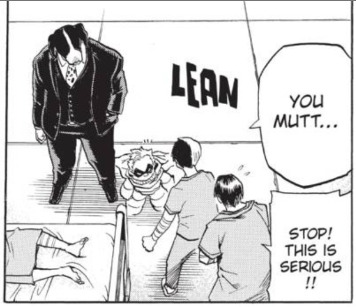
There are some sweatdrops and exhortations to get the kid to cool it, but those were ongoing before the animal words came out.
Chapter 57:
Gran Torino notes that the age they live in, for better or for worse, is one of suppression, and that the situation with Stain and the League will draw people out who are influenced by that ideology. Gran doesn’t elaborate on exactly what sorts of people he has in mind—All Might says only, “Then heroes will deal with them,”—but it’s an early hint that there are people in this society who feel unjustly suppressed. Crucially, Gran Torino doesn’t even necessarily think those people are wrong; he just thinks it’s a necessary evil. But what, exactly, is it that he’s grudgingly accepting as inevitable for the sake of maintaining the status quo? And how might his circumstances need to differ for him to have a different opinion?
In Chapter 27, we learned that producing support goods requires a government license; here we find out, courtesy of Giran, that dealing in and producing support goods without such a license is a major crime. So if you, for any reason, failed that “rigorous examination” to get cleared for support goods for quality-of-life reasons, you’re unlikely to find someone who’ll just provide them to you out of sympathy provided you keep quiet about where you got them. Instead, you have little choice but to turn to black market brokers—all because the government doesn’t think your quirk is affecting you negatively enough to qualify you for support equipment.
Again, this isn’t specifically about heteromorphs, but someone having an emitter quirk they can’t control well who needs the support item because they are choosing to pursue a career requiring them to learn that control is a very different case than someone who needs government support because of an immutable, always-on physical trait.
This chapter contains the first appearances of both Gigantomachia and Spinner, both fairly extreme heteromorphs: Machia for his size and rocky hide, and Spinner for animal traits considerably more prominent than e.g. Tokoyami’s bird head or even Tsuyu’s conglomeration of mildly froggy traits. Indeed, Spinner’s heteromorphic traits are so much more prominent than something like Jirou’s earlobes that it hardly seems accurate to even categorize their bodies the same way.
The sidebar for Daikaku Miyagi, the anchorman with the quirk that gave him two big horns who amputated one so that it would be less in the way during newscasts and other things that required there to be a camera on him. This in and of itself wouldn’t necessarily be notable, save that the same extra goes on to describe how the decision garnered some backlash from “a certain human rights group” who said that decisions like his fostered discrimination and were linked to the rejection of quirk-based society on the whole. Horikoshi further notes that he enjoys thinking about the lives and stories behind minor characters—even this far back, then, three and a half years before the introduction of the CRC, we have concrete evidence that the author was thinking about quirk-based discrimination and the politicization of heteromorphic features.
Chapter 59:
All Might drops some exposition about the Advent of the Exceptional, during which we see an image of a crowd full of implied-quirkless people holding up signs proclaiming their humanity and the monstrosity of those with quirks. Conversely, three of the four quirked people we see have obvious physical divergence from baseline human appearance. So from early on, that “monster” turn of phrase was heavily associated with changes in the physical appearances of those with special abilities. Later on, the PLF advisor at the hospital will tie these two things together explicitly.
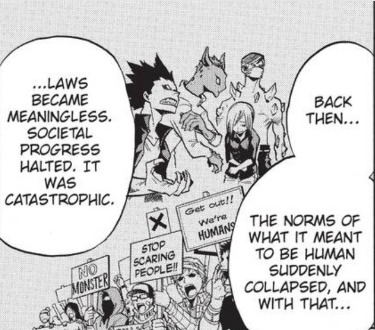
The Final Exams Arc (Chapters 60-69)
Chapter 61:
Ectoplasm’s character sheet. The teeth are creepy no matter which way you cut it, but they look much more profoundly unsettling when they’re right there on his unmasked face, as opposed to behind a black cowl, where you can let your eye fool you that they are in some way part of its design. His hero costume, naturally, includes the cowl, but his daily clothes do not—I wonder if he ever tried to have a gentle talk with Shouji about why Shouji wears the mask even in his downtime? I wonder even more how much the teaching staff in general, and Nedzu and Aizawa specifically, actually know about Shouji’s history.
o It’s also noted that Ecloplasm looks scary, but has received continued support after coming back to the job after losing both legs in a fight with a villain—we see this same pattern with Jeanist after Kamino. No word on how regular his support was before the traumatic double limb loss, though.
Chapter 66:
Nedzu, we find, was “toyed with by humans in all sorts of ways in the past.” Nothing we know about him suggests that he has any particular longevity, but his dynamic with Endeavor,[2] many chapters down the line, does suggest to me that he was at least on the staff when with Endeavor was at UA some thirty years ago. Thirty years is within the span of All Might’s career, well after society began to stabilize with the formalization of the Hero System. And yet, despite that, a sentient being, one with human—above human!—intelligence, was mistreated badly enough that he bears a grudge to this day. Nedzu is, again, not in precisely the same situation as a human heteromorph, but he serves as an indicator of what humans have, even in the age of heroes, been willing to do to those they think of as “animals.”
A shot of Koda and his mother, who look much alike. Interestingly, the biggest difference in their appearance is that she has horn-like protrusions that her son lacks. We’re a long way from the first quirk evolutions, and even farther from Koda’s quirk evolution, but we will later see Koda’s mother specifically tie those horns to her animal communication quirk becoming more powerful. This makes for another good piece of evidence towards Horikoshi having a grasp of heteromorphobia from early on, as the evidence is pretty good that Koda-mama got those horns as a result of a quirk evolution of her own, and those don’t happen under normal, non-stressful circumstances. More on Koda’s parents in a bit, as they're a pretty stand-out case in another way that isn’t immediately apparent here.
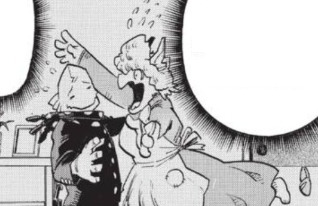
Can we call it foreshadowing for Koda defending Shouji at the hospital that Koda is wearing the same scarf as the main character in Horikoshi's Oumagadoki Zoo? Hmm. I'll leave that one to codenamesazanka.
Chapter 67:
A flashback panel to Mineta’s days in middle school. While I don’t doubt that there are P L E N T Y of reasons Mineta would be unpopular with the girls in his class, it is nonetheless notable that the popular boy getting showered with attention is perfectly baseline, while Mineta and his friends are not.
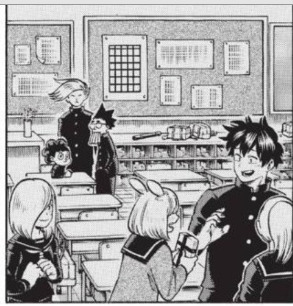
Note also that the cute heteromorph girl has long-ish ears and no other obvious divergent features.
Chapter 68:
Shouji and Iida are specifically called out to at the mall, trying to attract them as customers with claims that whichever storefront employee is hailing them can help them find anything they need. Midoriya mutters to himself about the difficulties of catering to everyone, given the many different types of quirks scattered across multiple age groups.
Crowd scenes at the mall show scattered numbers of heteromorphs, a somewhat higher number than usual for such civilian crowd scenes. The Kiyashi Ward Shopping Mall is noted for being the biggest and trendiest in the prefecture, with a variety that attracts lots and lots of people, so perhaps it’s no surprise to see somewhat more heteromorphs than usual there.
The Forest Training Camp Arc (Chapters 70-83)
Chapter 70:
Introduction of the Wild Wild Pussycats. A team of three Emitters and a Transformation-type, none of them in the slightest heteromorphic (give or take Tiger’s permanent :3 mouth), they nonetheless theme themselves after cats, including fake tails, big costume paw gloves, and cat-ear-esque headsets. It’s cute and unobjectionable in and of itself, but I do wonder what people like e.g. Officer Sansa think of it.
Chapter 71:
Shouji is missing from the hot springs scene. It doesn’t hugely stand out in the moment because Aoyama and Sero aren’t there either, but it does read a bit differently with the benefit of hindsight. Given the strong possibility that Aoyama is off doing Traitor Activities and Shouji is avoiding any possibility of having to torpedo the hot springs fun-times with an explanation of that time he was savagely beaten by people in his hometown right in an open street, it kinda leaves Sero as the only one who maybe just skipped for normal reasons, like that hot springs would gunk up his tape or something.
Chapter 73:
Bakugou addresses Ojiro as “Tail”—referring to him by his heteromorphic trait. He’s not even particularly angry at the moment; he’s just still nursing a grudge about Todoroki’s underwhelming performance in their Sports Festival match and wants to swap partners for the Test of Courage. Early Bakugou is very much a “judge a person by their quirk” sort.
Pixie Bob ushers Tsuyu and Ochaco into the woods for their turn at the Test of Courage by referring to the latter as Uraraka-kitty and the former as Ribbit-kitty.[3] While in the English, this reads as a baseline woman in a cat costume referring to the heteromorphic student by her animal-themed verbal tic and the baseline student by her actual name, uraraka is a fairly onomatopoeic way to say bright and cheerful. I would guess that Pixie Bob is probably referring to Ochaco’s personality here, which makes it somewhat less egregious. It won’t be the last time someone refers to Tsuyu via the frog sound instead of her name, though.
Chapter 75:
Mandalay telepathically compliments Spinner, calling him both cool and handsome. While I doubt he’s the only person in the world who’d react the way he does—he blushes, gets flustered, and missteps, giving Mandalay an opportunity to attack him—the moment does get some new context when you consider how everyone called him “the lizard freak” in his hometown. Approximately zero people calling him cool and handsome back there, one imagines! Having it immediately turn out to be a ploy likely informs some of the outraged anger in his response.
Chapter 81:
Mandalay points out that Spinner never used his quirk during their combat, implying that she doesn’t think just his lizard-like appearance or his claws “count.” Chalk another one up to the classification problems of “heteromorph” as a descriptive term. This will turn out to rather neatly illustrate one of the issues I’ve been talking about with regard to the way heteromorphs are unfairly disadvantaged by the current laws about public quirk use. Remember, a “Villain” is someone using their quirk illegally. So if Mandalay doesn’t think Spinner used a quirk here, and since he has no record, why does he get categorized as a Villain instead of just a garden variety criminal?
Now, one could say that by associating with the League of Villains, Spinner is rather claiming the designation for himself, and we don’t know how the legal system will technically classify him, when and if he ever actually faces trial. To that, I would say to hold the thought, because Skeptic will eventually back me up on the, “Heteromorphs are unfairly targeted by Villain designations,” claim all but word for word.
BONUS CHAPTER 1: Tsuyu’s Ribbety Diary
We meet Tsuyu’s family, all various froggy types. They’re a cute family, but the husband and wife both being froggy kind of raises some questions about pressures that might exist about marrying your same “type,” or at least refraining from marrying anyone too obviously not. I’d be more willing to wave it off if not for two things.
First, we get the same sort of scenario from Spinner’s character sheet, that his is “a family full of reptilian quirks.” Second, there are very few romances in the series between someone close to “baseline” and someone with a more extreme heteromorphic appearance. The most obvious, clear-cut, canonical example is Koda’s parents—his dad has slightly weird hair but is otherwise entirely baseline; we see him defending his wife from other peoples’ mockery. That, of course, is a single panel limited to a flashback inside a flashback, so not exactly very visible to the reader! The next-most significant one I can come up with is Natsuo and his mouse girlfriend, who has likewise been seen in one (1) panel, had no dialogue, and whose appearance and identity were so incidental the anime deleted her entirely.
Who’s next? Well, if you assume all those No Comments from Kamui Woods and Mount Lady about their relationship are indicative of a relationship between them, they’d be another, though we don’t actually know what Shinji actually looks like under his mask, only the implication that it’s divergent enough that he prefers to cover his face. Next up on my tally would be Thief Takami and Tomie, but since the sum total of Takami’s animal traits are tiny little elbow wings, you can see how fast the drop-off is there.
Compare this to the number of pairings/families we have between people of like type: Bakugou’s parents, Iida’s, Jirou’s, Aoyama’s, Tsuyu’s, Ochaco’s, Shouto’s, Toga’s, Spinner’s, and Tomura’s whole family on both sides.
Then you get the ship-teasy stuff that’s more about crushes, people dating, or hints that are perceived as pointing towards epilogue romances: Deku and Ochaco, Jirou and Kaminari, Shindo and Yo, Gentle and La Brava, Miss Joke’s flirting with Aizawa, and Toga’s variety of crushes (among which Tsuyu is the most distant from Toga’s own body type).[4] I think Kirishima and Mina are right on that borderline, with Mina having a normal body type but a collection of minor but highly visible divergent traits.
So like, the vast, vast majority of the romantic relationships in the show are between relatively baseline people. In that context, it sticks out like a sore thumb to me that Tsuyu and Spinner are both explicitly said to have the same type of animal heteromorph quality on both sides of their family tree. It’s not an incest concern or anything, just that I wonder what the pressure is on cross-type couples, or what social circles look like post-graduation.
Two classmates talk about how it’s hard to tell what Tsuyu is thinking; one of them says, with her eyes hooded and a kind of cool expression, “That expression of hers never changes. Maybe ‘cuz she’s a frog?”
Tsuyu tells us that she never really made any friends; while some of this may simply be because Tsuyu didn’t have much time to socialize, between hero training and looking after her family, it’s also true that all of her classmates that we see have baseline appearances.
This lasts until she starts getting stalked by a snake-headed heteromorph girl named Mangusu Habuko—a fellow loner. Tsuyu is initially frightened by Habuko’s behavior, but has an intuitive sense for what the deal is, that Habuko wants to be friends but is awkward and doesn’t know how to broach it.
When asked if she wants to be friends, Habuko flips out. She calls herself treacherous and untrustworthy; she calls Tsuyu a foolish frog and says she must be joking, and that she should choose her friends more carefully. She then immediately dissolves into tears. Somehow, I doubt all this self-loathing about her innate nature manifested out of thin air!
The Hideout Raid Arc (Chapters 84-97)
Something that’s observable throughout this arc is that we’re in another sequence, like the Sports Festival, where the percentage of people with heteromorphic features in the crowd shots tends to run a bit higher than the norm of the series to date. Unlike the Sports Festival, though, these crowds are just civilians, not heroes. So what’s the difference between Kamino and the earlier on-the-street crowd scenes?
Well, the neighborhood the Noumu warehouse is in is a somewhat rougher area. Part of the visual shorthand for that is people in edgier clothes, stuff that’s indicative of districts with bars, clubs, sleazy hangout spots, and so forth, but another shorthand is an increased number of heteromorphs.
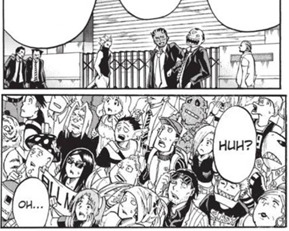
These panels are respectively from Chapters 87 and 92.
Chapter 87:
The character sheet for Kamui Woods notes that the story of his early childhood is “grand and compelling,” and that his story was made into a documentary. That, to me, has Inspiring True Story written all over it. Probably not coincidentally, Kamui Woods is another character whose face we’ve never seen. As more pointing in the direction of him having a childhood marked by severe discrimination, he’s not sure of his age—it’s given as “29 since he started counting.” So was he abandoned as an infant for his weird face? I could come up with other explanations, all equally over the top (extreme confinement, for example, that left him unable to properly mark the passage of time), but the fact that he can’t e.g. look up a birth certificate for himself suggests that whatever went so wrong for him, it happened very early.
…Though I suppose there’s the possibility that he’s not human, but rather a tree that manifested a quirk. As documentary-worthy origins go, though, that feels less Inspiring True Story and more Educational Biopic About Rare Phenomenon.
The Provisional Hero License Exam Arc (Chapters 98-121)
Chapter 99:
Shouji’s room is shown, all but barren. He says that he doesn’t care much about owning things, but knowing what we come to know about his history, it’s easy to wonder if he really doesn’t care about owning things or if this is rooted in a childhood in which it was believed that anything he touched would be polluted. Not a situation that led to him being given much of his own, one suspects!
Chapter 103:
This chapter introduces Yokumiru Mera, from the HPSC, who gives an opening statement that has some very interesting ruthlessness lurking in its subtext. Particularly relevant to our current topic is his comment that in the modern era, the time it takes to resolve a given incident is incredibly short, so the test that year will be prioritizing speed. Prioritizing speed (wouldn’t want some other hero to get the metaphorical kill first, after all!) is a surefire way to guarantee that heroes are not taking the time to really examine all factors in a situation or make any attempts whatsoever at calm, considered de-escalation, but rather are just making snap judgements based on their biases and gut reactions. Guess what group of people that’s going to disproportionately impact?
o Now, it’s notable that Mera says the test prioritizes speed, but the conclusion many others come to is that the test only pretends to do so; that actually, it prioritizes care and information gathering. Indeed, we find a few chapters later that the actual priority is teamwork, as requested by police higher-ups—the idea is to fill in the gap left behind by All Might with hero squads that work well together.[5] However, while the intention may be to gather those good at teamwork, it certainly doesn’t stop people like Shouto and Inasa from cruising through—and, in any case, whether the groups learn teamwork or not doesn’t take away from an HPSC rep telling them to their face that speed of incident resolution is one of the most important things to a modern hero and never following that up with any kind of amendment or clarification.
Chapter 107:
Introduces the HUC, or Help Us Company, professionals trained to act as victims in disaster rescue exercises. Given that context—what they’re communicating to students training to understand what “victims” look and act like—it’s extremely worth examining what they, well, look like.
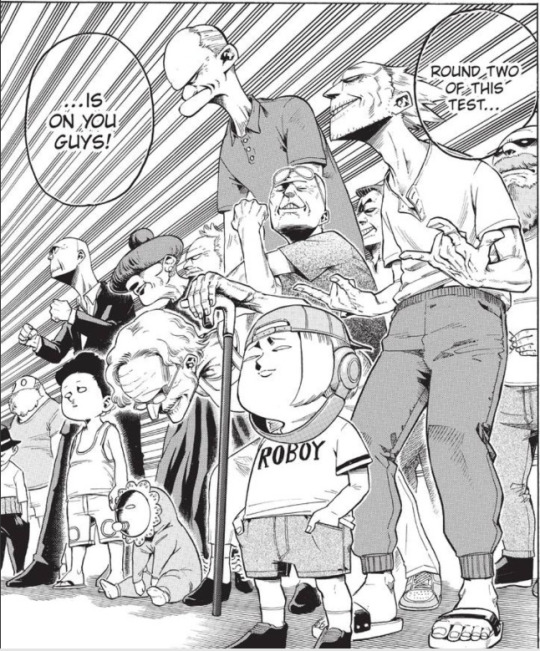
God, this is so Yikes.
And having asked that question, we find that the only people in this group that might not be baseline—the ones with short, childlike statures—are dressed to emphasize that stature. The end effect is a crowd of “victims” with not a single heteromorphic representative.
Chapter 109:
Shiketsu’s class rep, Mora Nagamasa—the extremely hairy one—approaches Bakugou to extend an apology for Shishikura’s behavior during the exam. It’s noticeable here that, having matured somewhat since Early Series Bakugou, and having been approached in downtime in a reasonable manner, Bakugou manages to refrain from coming up with any demeaning nicknames centered on Mora’s appearance. Kirishima remarks internally on all the hair, but only internally; he’s much too polite to say anything out loud.
Chapter 110:
A big splashy introduction for the man ranked #3 in the Heroes Who Look Like Villains ranking, Gang Orca. He’s at the test to play villain and is, just as noticeably as all the play-victims are baseline, a heteromorph. At the time of his introduction, he’s ranked Number 10 in the Hero Rankings, but will be bumped out later on. This does, however, make him the highest-ranked known heteromorph who doesn’t have a human face,[6] with the possible exception of Kamui Woods—who, like Shouji, covers it with a mask.
Gang Orca’s character sheet notes that, while he’s a popular guest at aquariums, his intimidating face and “stony personality” always result in weepy children. He apparently finds this relatively upsetting (“lots of angst”) but, unlike Shouji or Kamui Woods, has not taken to wearing a mask, nor trying to tone down his personality on any level—to the contrary, Present Mic suggests much later on that he exaggerates it.
-----------------
Next time, I'll cover from the Shie Hassaikai arc through the end of Joint Training. Thanks for reading!
---------------------
FOOTNOTES
---------------------
[1] Initially. He sticks to his guns long enough that he gets away with it in the end, though.
[2] The big tell is that Nedzu addresses Endeavor as Todoroki-kun rather than Todoroki-san or simply by his hero name, but his observation that Todoroki-kun has “matured” (literally in the Japanese, “become an adult”) doesn’t hurt, either.
[3] Kerokero neko and Uraraka neko.
[4] You can get further out there with this, but by the time you get to e.g. Shouto and Momo or Ojiro and Hagakure, the ice is definitely getting thinner on whether you’re seeing groundwork for future wedding bells or just reasonably close male/female friendship. Your mileage may vary depending on how tightly attached your shipping goggles are or how cynical you are about shounen authors’ tendencies towards timeskip marriages. Also, I can’t be bothered to dig up and list out the crushes or shipping patterns among the Class B kids. Koroiro likes the mushroom gal?
[5] Note that Mera phrases this as being merely a stopgap until they find the next All Might. The HPSC is not so eager to change the methods they’ve come to rely on over the last thirty some-odd years!
[6] We don’t know enough for me to say for sure whether Wash is a heteromorph.
#bnha#heteromorph discrimination plot#my writing#bnha meta#bnha worldbuilding#huc for no. 1 group that needs to have mandated diversity hires#seriously there needs to be a lawsuit or something#where's that “certain human rights group” when you need them
77 notes
·
View notes
Text
Considering Fjord’s just barely “I guess my last name is Stone. That’s the shit name they gave me at my shit orphanage” attitude. I propose that when they marry we break with tradition and just let him be Admiral/Captain-Mr Fjord Lavorre.
#critical role#Plz understand even in our own world naming customs are so much more diverse than#women takes mens last name or maybe their husband adds her. Which each got form their father#There are so many other naming customs#It’s honestly weird to be exandrian doesn’t have more of them#Go look up Spanish names rn#Or places where they don’t have last names at all#Or are still using the “child of (ok usually father but you could use mother or parent)#On the one hand I get they worldbuilding based on what they know#On the other… the world is way more complicated than that#Marriage customs are different between cultures and time periods!#Not everyone uses rings!#Its fine but… also I have a lot of opinions#(Idk why this turned into a rant but it did)#cr spoilers#critical role spoilers
74 notes
·
View notes
Note
hiiii! have you considered releasing tradewinds as a single purchase through a site like gumroad?
Hi anon!
So the reason Tradewinds was shelved and not published like 8 years ago, is because I couldn't find an Aboriginal sensitivity reader willing to read m/m with disturbing themes. I had sensitivity readers for the other side of things (like Matan and his heritage), but I kept either not finding anyone, or the one person I found took my $200 USD deposit and vanished and never spoke to me / responded to any of my emails.
As a result, I was uncomfortable distributing it anywhere broadly, even though I was relatively confident the novel isn't offensive, because I just don't know 100%.
I am a lot more confident releasing it via subscription as an exclusive novel, because the people who pay for subscription are often folks who are a) already used to my style of writing and b) generally know what to expect from me, vs. cold audiences who don't. I'm kind of kicking myself that I didn't realise that Tradewinds would make a great exclusive/paywalled release for subscription, because it means it's only ever going to find a very narrow bandwidth of readers.
Basically if I could release it for single purchase - as basically an ebook - I would have released it like 8 years ago, anon. And the reason I have actually released it this specific way is down to the fact that I'm just not really confident offering it for broader distribution.
That might change one day, if I happen to stumble across a sensitivity reader who is okay with my style of writing, who is reputable + has references (i.e. so I know I won't lose a fair chunk of money in the process, because that burned me pretty badly, not gonna lie). But until then, having Tradewinds be limited is the only way I'm comfortable releasing it at all.
Folks are more than welcome to sign up for one month, download the book (and read any other early access they want) and then leave. They can even just put 'I only wanted one thing and now I have it' in the exit survey so I know what they were there for if they want. Then it's still a single purchase (with some early access extras), and they still access the downloadable file. :)
#asks and answers#tradewinds#merchantverse#tradewinds was shelved not because i think it's a bad book#but because i wasn't comfortable going to broad distribution without a very specific kind of sensitivity reader#it was actually meant to be the series i started publishing with#long before perth shifters existed#and then i realised that through writing a highly diverse cast#i might have actually really hurt the future of the series#and had to shelve the whole thing and all the worldbuilding#i really don't regret tradewinds at all#i like the book and i love the characters#but yeah it was complicated#what i thought would be an 'easy' problem to solve was really difficult in part because#'sensitivity readers' is a very USA concept and certainly was back then#and a lot of the folks i enquired with who did offer sensitivity reading on Aboriginal Australian matters#didn't read m/m or didn't want to read anything problematic / with any disturbing themes#which i can understand#but literally reduced my pool to '0 plus that one person who took $200 USD from me at a time when i had to skip medical appts because of it#i'm sure it would be better now#but i'm also happy to offer a novel to folks who sign up to the patreon / ream account#since that is my main and primary income
25 notes
·
View notes
Note
I just finished your demo and i absolutely love it! The character customization is amazing as well. It’s implemented through out the story as i read along.
Another thing i’m happy for is the amount of Black/POC characters that are ROs or not. Interactive fiction is a very niche genre and most writers don’t include black characters as much. Kinda makes me feel isolated from the story and feel less immersed into the story. But i don’t have a problem with this one, Which I’m grateful for. 😊
Ah thank you! It's such a relief that it's coming across well. I love when character customization matters, but writing this has made me appreciate the work that goes into it even more.
And thank you for loving my characters! I wanted the story to feel vibrant and diverse in a believable and natural way that many parts of the world are. As I've said before, I love the fantasy genre, but the world is too wide for us to just draw on one cultural influence for our worldbuilding. Plus I know the isolating feeling that comes with consuming media where you're clearly either an outlier or an afterthought. So it makes me so happy that my black and poc characters are getting some love!
#interactive fiction#honor amongst thieves#if wip#game development#interactive novel#worldbuilding#hat if#such kind readers#diversity in media
33 notes
·
View notes
Text
With the reveal of an NB character in Ninjago, I feel that people are placing this theme on a pedestal because of this one single move of inclusion. Don't get me wrong— I'm glad that LEGO is including LGBTQIA+ identities into their themes, and I genuinely hope they continue doing so, but we're forgetting that they're investing a step forward into a theme that's always going two steps back.
I don't feel like pointing out the issues of Ninjago, especially because it's tiresome and it's not the point of this post, but I remember that there was an entire thread here on Tumblr about the problematic worldbuilding of Ninjago. I might write something about it as well, but it's unlikely.
Chima had a great amount of inclusion and diversity within its cast (though no canon LGBTQIA+ characters, unfortunately):
POC-equivalent characters (brown and blue crocodiles; vultures with tan and bright blue skin colors), of which a few of those are part of tribes that have a motif from predominantly white cultures (Longtooth and Lavertus, who are brown lions in a tribe with a roman motif; Ehboni, Eglor, who are black and dark blue respectively, alongside unnamed eagles of mixed origins [dark blue x white] in a tribe of greek motif, and even Ewald himself isn't white).
A majority of these characters are important to the plot and/or have reoccurring appearances;
Diversity in tribe lifestyles, with the Wolf Tribe being nomadic (and not going through the stereotype of nomadic traders).
Each vehicle in Chima follows the motif and lifestyle of their respective tribe. For example, crocodiles are ambush predators and require camouflage, thus their vehicles are heavily based on military vehicles, with camo colors and strong silhouettes;
Marginalized characters whose arcs actually end with them winning and gaining respect. The Ice Hunters vs. Phoenixes arc was an obvious allegory of colonization, and it ends with the Ice Hunters alive and thriving, while the Phoenixes (who started the war) lost and failed to 'educate' their enemies.
The Crawlers also have their arc finished with an anti-war and pro-diversity lesson, where Laval lends them Chi because it's not supposed to be earned, and instead is free for everyone, even though they had stolen all of Mount Cavora's Chi beforehand;
Characters whose appearance is distinctive and break barriers of ableism are not only present in Chima, but are also treated equally to other characters, without having their differences be a point, argument, or lesson. (Cragger with a blind eye, Crug with a prosthetic jaw, the Raven Tribe as a whole, Leonidas with distinctively shaped incisors and Longtooth with long canines).
However, the Rhinoceros Tribe is an unfortunate exception, as they're constantly depicted as dumb;
The Lion Tribe has a lot of diversity by itself, with lions having a variety of mane colors that represent hair colors in real life. Laval has red hair, Leonidas is ginger, Lavertus is blond, Lennox has brown hair;
Other cultural representations such as Dom de La Woosh being based on Brazilian carnivals;
There's Wonald, a vegan character;
My favorite fact of all: Chima and Chi are both real words who exist in multiple languages, and each of their meanings was instrumental to the interpretation we have in this theme. → Chi means: knowledge in japanese; water (literally) and source of life (figuratively) in chinese; god in igbo. Chima means "god knows all" in igbo → in LoC, the Phoenixes created Chi, which looks like water and is the source of life/knowledge in Chima, and they also sculpted Mount Cavora with each tribe's heads before they had even evolved.
All of this unfortunately flew over most people's heads, which is a bad thing, as all of the effort that was put on Chima's diversity was left unnoticed, but it is also a good thing at the same time, because everything was executed seamlessly and naturally, just like how people should view each other in real life (view one another without discrimination). However, this amount of care and thought put into adding a diverse cast of characters is probably not going to be seen again, in any lego theme or any story made by corporations/companies.
#lego chima#lego legends of chima#legends of chima#diversity#inclusion#inclusivity#diverse characters#inclusive design#inclusive writing#respect#anti war#anti ableism#equality#world building#worldbuilding#for chima#lego
26 notes
·
View notes
Note
What else could transformers find attractive and what kind of beauty standards might they have?
(That are logical and not replicating human ones for humans titillation)
I always HC that biolights can be a good indicator of health and/or attractiveness, but I'm biased because I love them dearly. Because, logically to me, if a mech is sickly or stressed, their biolights and optics will be flickering slightly (or more than slightly) or sometimes / often dim.
Logically speaking having a clear and shiny paintjob would be a sign of attractiveness because it shows both they take care of themself and can afford to maintain a consistent paintjob (though I think this varies greatly, with scars in some areas being considered a badge of honor and a sign of winning, in some areas there are higher paint job requirements than other, some areas just forgo the custom entirely)
Bright colors = conventionally attractive makes sense with a similar psychology, especially with how common it is on earth too. I can see a whole ass THING too among the higher castes / classes about being able to afford all sorts of artificial highlights, temporary like makeup or "permanent" (though it wouldn't be permanent-permanent, simply difficult to remove and long lasting, especially if we believe in paint nanites here)
#maccadam#transformers#I can't come up with any more currently#tf worldbuilding?#though this is me looking at it through like the ornithologist crouching behind the bush sort of perspective here#don't even get me started on how the decepticons are a breeding ground for cybertronian goth culture becoming more diverse and popular#at least for tfp#i will never recover from that time someone called Megatron a goth girl in the asks and i don't want to recover from it
26 notes
·
View notes
Text




Felidian ref sheet is done! Feel free to draw one!
Note: Cehuacelotls will have their own reference sheet. So expect it for later.
#Open species#fantasy race#original content#furry art#ref sheet#The cats!#Pretty diverse bunch tbh#myart#worldbuilding#oc#characterart
7 notes
·
View notes
Text
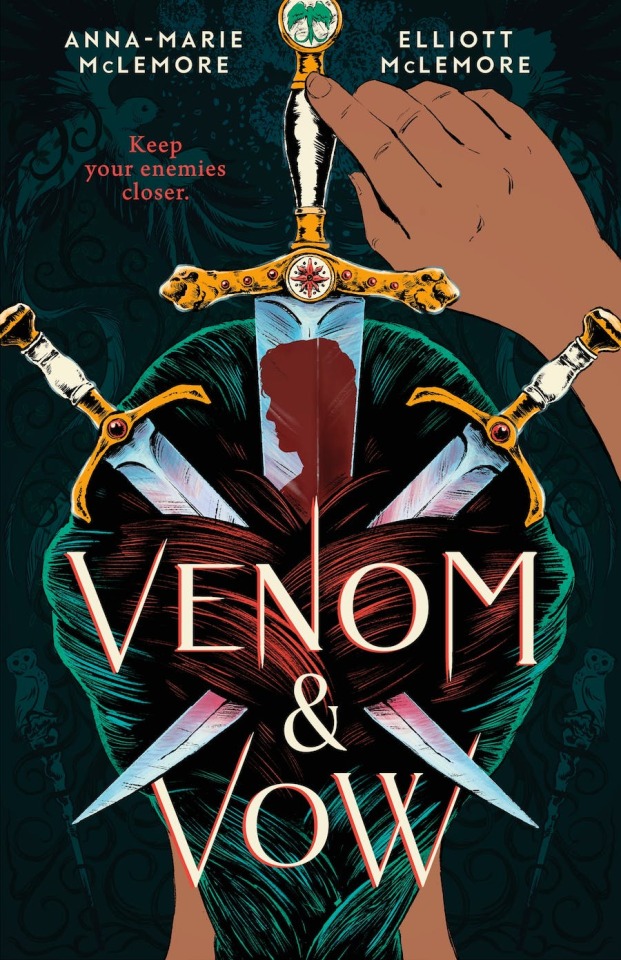
2023 reads // twitter thread
Venom & Vow
YA high fantasy about two enemy kingdoms whose leaders have been cursed to sleep, and are being run by the teen heirs
a bigender dama/assassin and trans prince are both trying to find the enchanter from the other kingdom who they believe is responsible
two disabled MCs (cane users)
#aroaessidhe 2023 reads#Venom & Vow#this is a fine ya fantasy - but I found the plot/execution a bit generic unfortunately#(aside from the diversity etc; but I personally need more than that)#there are some really cool worldbuilding aspects -magically changing castle; a smidge of fey myth and cool creatures#also the mix of celtic + latine cultures is interesting!#but i feel like it isn't explored in full#i do think AMM excels more at low-plot contemporary magical realism narratives#vico ortiz audiobook!!#why vico giving the boys a scottish accent (i think?? im bad at recognising accents) but the other VO american????#the monastery for trans people transitioning is a great concept#at one point there's a bit of a weird line ‘they didn’t sound like the cries of someone assigned male at birth’ .....which...#understand the intention. i feel like that circles back around to being transphobic tho
15 notes
·
View notes
Text
A lot of fantasy draws from European cultures with similar kinds of names, fantasy creatures and feudal structures, but you can still have human diversity in your world-building and it feel natural. After all, black and Asian people are a part of European real-life history and culture and always have been. The world has always been a big place and migration, trade and human will have always been the game.

A trap writers can fall into is to make the cultures they base their fantasy on even "whiter" than they were in real-life mostly due to historical misconceptions. Europe has had constant interactions with North African and Asian populations going back thousands of years, from Arab kingdoms and Sultanates to the Ottomans and the Silk Road. The Romans were aware enough of China enough to call it Serica, and China were also aware of them. Meanwhile, the Roma and Sinti groups, who are originally from India, have been in Europe for over 700 years. There were hundreds of black people living in Tudor London to the point Queen Elizabeth I complained. There were black people like John Blanke, a musician present at Henry VIII coronation, as well as Dederi Jacquoh, who came from what would later become part of Liberia and was baptised in England in 1610. From the Sons of Africa abolition group to black and Asian soldiers serving in WW1 and WW2, POC have always left their mark.
No matter what people are people, and world-wide they have their own individual agency and are often prone to migration as simple as hopping on a boat or raft, or riding horse or camelback or just walking for days, weeks and months in great pilgrimages. Diversity isn't new or modern, it's a natural part of human history, and to remove it can make a fantasy worlds feel less natural, more produced, compartmentalised and artificial. Writers should always give their world some nuance and unexpectedness, wonder and humanity.

#historical accuracy#creative writing#diversity#worldbuilding#period drama#fantasy writing#black characters#poc characters#asian characters#europe#european history
6 notes
·
View notes
Text

deep gnomes' eyes should look like this aboveground
#drow too but you guys know what I'm about#small brain: jay's art style has evolved away from drawing pupils#big brain: actually jay only ever draws fuckin gnomes and their pupils are just like soooo constricted in bright light#... I can't even commit to the bit without being a nerd forest and rock gnomes' pupils don't constrict this much#they're not as light sensitive they're active partly aboveground and partly during the day#so naturally their eyesight is adaptive to diverse lighting conditions#actually apparently tarsiers' eyes are Like This partly because they don't have a tapetum lucidum... much to think about.#I'm not canceling this shitpost because I keep googling while writing it but I do keep googling in the middle of writing it#did you know there's a general trend toward nocturnal owls having dark eyes and more diurnal/ crepuscular owls having bright eyes#anyway#gnome stuff#worldbuilding
4 notes
·
View notes
Text
L + ratio + fishmen are just knockoff fantasy orcs + like most other races/tribes in 1pc they are either opressed mages quirky humans and indigenous stereotypes, which are sometimes mixed up which makes everything overly complicated and Worse + the mermaids and fishmen separation is misogynistic and fake because there is mermen and fishwoman but oda is a coward
#1pc#critgon.oidea#I was going to discuss with the person who made the post but she restriced the replies#it is a pretty mediocre attempt of making 1pc’s worldbuilding look deep as if he didn’t have the shandians + devil fruits already#also the fishmen being stand-in for black people is definitely not good#and it’s made worse since the design diversity is pretty low#atla is the best of the worst example because they treat opressed people badly but at least it isn’t some garbage#like the fire nation being the only ones who don’t bend while the others do and btw there’s people with three eyes
3 notes
·
View notes